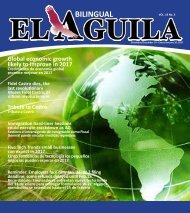El Aguila Magazine – December 16, 2015
Create successful ePaper yourself
Turn your PDF publications into a flip-book with our unique Google optimized e-Paper software.
<strong>El</strong> <strong>Aguila</strong> Diciembre/<strong>December</strong> <strong>16</strong> - Enero/January 12, 20<strong>16</strong> PRIMER PLANO/FRONT PAGE<br />
Viendo hacia abajo: La forma en que fijamos nuestra mirada<br />
en el suelo podría ayudar a salvar el clima<br />
Por profesores e investigadores de la Universidad de Sidney: Budiman Minasny, Alex McBratney, Brendan Malone, y miembro investigador Uta Stockmann<br />
3<br />
Los suelos del mundo podrían<br />
ser un aliado clave<br />
en la lucha para limitar<br />
el calentamiento global a 2 C,<br />
gracias a su capacidad para almacenar<br />
carbono y tener gases<br />
de efecto invernadero de la atmósfera.<br />
<strong>El</strong> Ministro de Agricultura de<br />
Francia, Stéphane Le Foll ha<br />
fundado un ambicioso programa<br />
de investigación internacional,<br />
llamado “4 pour mille” (“4<br />
por 1000”), cuyo objetivo es<br />
aumentar la cantidad de materia<br />
orgánica que contiene carbono<br />
en los suelos del mundo<br />
en un 0,4% cada año.<br />
<strong>El</strong> programa fue puesto en marcha<br />
en la Cumbre del Clima de<br />
las Naciones Unidas en París,<br />
con la esperanza de inscribir a<br />
tantas naciones como sea posible.<br />
¿Cuánto carbono almacenan<br />
los suelos? Mucho. A unos 2,4<br />
billones de toneladas de carbono,<br />
el suelo es la fuente de<br />
carbono terrestre más grande,<br />
y los 2 metros superiores de<br />
los suelos del planeta poseen<br />
cuatro veces más carbono que<br />
todas las plantas del mundo. <strong>El</strong><br />
carbono almacenado en el suelo<br />
también puede permanecer<br />
allí por un tiempo muy largo en<br />
relación al carbono en las plantas.<br />
Gracias a los mapas publicados<br />
recientemente de las reservas<br />
mundiales de carbono<br />
en el suelo, podemos averiguar<br />
cuánto carbono extra se necesita<br />
almacenar en los suelos (y<br />
dónde) con el fin de cumplir el<br />
objetivo.<br />
Hay aproximadamente 149 millones<br />
de kilómetros cuadrados<br />
de tierra en el mundo, por lo<br />
que si se dispersa todo el carbono<br />
del suelo en el mundo por<br />
igual habría <strong>16</strong>1 toneladas por<br />
hectárea. Llegar al objetivo del<br />
0,4% significaría el aumento de<br />
las reservas de carbono del suelo<br />
en 0,6 toneladas (600 kg) de<br />
carbono por hectárea por año,<br />
en promedio.<br />
Pero, por supuesto, los suelos<br />
de todo el mundo varían ampliamente<br />
en el almacenamien-<br />
to de carbono - suelos de turba<br />
tropicales, por ejemplo, tienen<br />
alrededor de 4.000 toneladas de<br />
carbono por hectárea, mientras<br />
que los suelos arenosos de las<br />
regiones áridas sólo podrán contener<br />
80 toneladas por hectárea.<br />
<strong>El</strong> tipo de vegetación encima de<br />
la superficie y la rapidez con qué<br />
los microbios del suelo utilizan<br />
el carbono también puede afectar<br />
a la cantidad de almacenamiento.<br />
En términos generales, solamente<br />
un cuarto de la materia orgánica<br />
añadida al suelo termina<br />
siendo almacenada como carbono<br />
a largo plazo.<br />
Los agricultores y otros propietarios<br />
de tierras tendrían que<br />
obtener información detallada<br />
sobre qué es exactamente lo que<br />
ellos necesitan hacer en sus propios<br />
suelos para aumentar el carbono<br />
almacenado en la cantidad<br />
necesaria.<br />
Estudios de todo el mundo sugieren<br />
que el carbono del suelo<br />
potencialmente puede ser almacenado<br />
a una velocidad de 500<br />
kg de carbono por hectárea por<br />
año - ligeramente por debajo del<br />
objetivo medio - al reducir la labranza<br />
y la siembra de cultivos<br />
de cobertura de leguminosas.<br />
Estas estimaciones varían con<br />
el tipo de suelo y las regiones<br />
climáticas. Nuestra investigación<br />
sugiere que algunas zonas<br />
de tierras de cultivo del mundo<br />
tienen el potencial para alcanzar<br />
el objetivo del 0,4%, al menos a<br />
nivel local, a través de más modestos<br />
aumentos generales en<br />
el almacenamiento de carbono.<br />
Crédito Foto: <strong>El</strong>ena Arkadova/Shutterstock.<br />
Restaurar el contenido de carbono<br />
del suelo en estas zonas es una<br />
situación de ganar-ganar, ya que<br />
compensará las emisiones de gases<br />
de efecto invernadero y aumentará<br />
la calidad del suelo al mismo tiempo.<br />
Uno de ellos es Australia, donde las<br />
estimaciones de carbono del suelo<br />
actuales sugieren que el objetivo del<br />
0,4% podría cumplirse al aumentar<br />
el carbono del suelo por apenas 220<br />
kg por hectárea - algo que fácilmente<br />
podría ser entregado en los lugares<br />
que no están sufriendo la sequía.<br />
Eyes down: how setting our sights on soil could help save the climate<br />
The world’s soils could be<br />
a key ally in the fight to limit<br />
global warming to 2 C,<br />
thanks to their ability to store carbon<br />
and keep greenhouse gases out<br />
of the atmosphere.<br />
France’s agriculture minister<br />
Stéphane Le Foll has founded an<br />
ambitious international research<br />
program, called “4 pour mille” (“4<br />
per 1000”), which aims to boost<br />
the amount of carbon-containing<br />
organic matter in the world’s soils<br />
by 0.4% each year.<br />
The program launched at the United<br />
Nations climate summit in<br />
Paris, with the hope to sign up as<br />
many nations as possible.<br />
How much carbon do soils store?<br />
A lot. At about 2.4 trillion tonnes<br />
of carbon, soil is the largest terrestrial<br />
carbon pool, and the top 2 metres<br />
of the planet’s soils hold four<br />
times as much carbon as all the<br />
world’s plants.<br />
Carbon stored in soil can also stay<br />
there for a very long time relative<br />
to carbon in plants.<br />
Thanks to recently published maps<br />
of global soil carbon stocks, we<br />
can work out how much extra carbon<br />
needs to be stored in soils (and<br />
where) in order to meet the target.<br />
There are roughly 149 million<br />
square kilometres of land in the<br />
world, so if all the world’s soil<br />
carbon were dispersed evenly there<br />
would be <strong>16</strong>1 tonnes per hectare.<br />
Hitting the 0.4% target would<br />
mean increasing soil carbon stocks<br />
by 0.6 tonnes (600 kg) of carbon<br />
per hectare per year, on average.<br />
But of course, soils around the<br />
world vary widely in carbon storage<br />
<strong>–</strong> tropical peat soils, for example,<br />
hold about 4,000 tonnes of<br />
carbon per hectare, whereas sandy<br />
soils in arid regions may only hold<br />
80 tonnes per hectare.<br />
The type of above-ground vegetation<br />
and how quickly the soil<br />
microbes use the carbon can also<br />
affect the amount of storage. Generally<br />
speaking, only a quarter of<br />
organic matter added to soil ends<br />
up being stored as carbon in the<br />
long term.<br />
Farmers and other landowners<br />
would need detailed information<br />
about what exactly they will need<br />
to do to their own soils to boost<br />
their stored carbon by the required<br />
amount.<br />
Studies around the world suggest<br />
that soil carbon can potentially be<br />
stored at a rate of 500 kg of carbon<br />
per hectare per year <strong>–</strong> slightly<br />
La aspiración “4 por 1000” es ambiciosa,<br />
pero quizás aún más importante<br />
es el efecto que esta iniciativa<br />
tendrá en la promoción de<br />
la buena gestión de los suelos, que<br />
a su vez puede ayudar a mitigar el<br />
cambio climático.<br />
Al fomentar las prácticas agrícolas<br />
que almacenan más carbono, también<br />
podemos ayudar a los agricultores<br />
a mejorar la calidad de sus<br />
suelos y aumentar la seguridad alimentaria,<br />
al mismo tiempo.<br />
Fuente: La Conversación<br />
By professors and researchers of the University of Sidney: Budiman Minasny , Alex McBratney , Brendan<br />
Malone, and research fellow Uta Stockmann<br />
below the average target <strong>–</strong> by reducing<br />
tillage and planting legume<br />
cover crops.<br />
These estimates change with soil<br />
type and climatic regions. Our research<br />
suggests that some cropland<br />
areas of the world have the potential<br />
to hit the 0.4% target, locally at<br />
least, through more modest overall<br />
increases in carbon storage. Restoring<br />
the soil’s carbon content in<br />
these areas is a win-win situation,<br />
as it will offset greenhouse gas<br />
emissions and boost soil quality at<br />
the same time.<br />
One such place is Australia, where<br />
current soil carbon estimates suggest<br />
that the 0.4% target could be<br />
met by boosting soil carbon by just<br />
220 kg per hectare <strong>–</strong> something that<br />
could easily be delivered in places<br />
that are not suffering drought.<br />
The “4 per 1000” aspiration is an<br />
ambitious one, but perhaps even<br />
more important is the effect this<br />
initiative will have on promoting<br />
good soil management, which in<br />
turn can help to mitigate climate<br />
change. By encouraging farming<br />
practices that store more carbon,<br />
we can also help farmers improve<br />
the quality of their soils and boost<br />
food security at the same time.<br />
Source: The Conversation
















